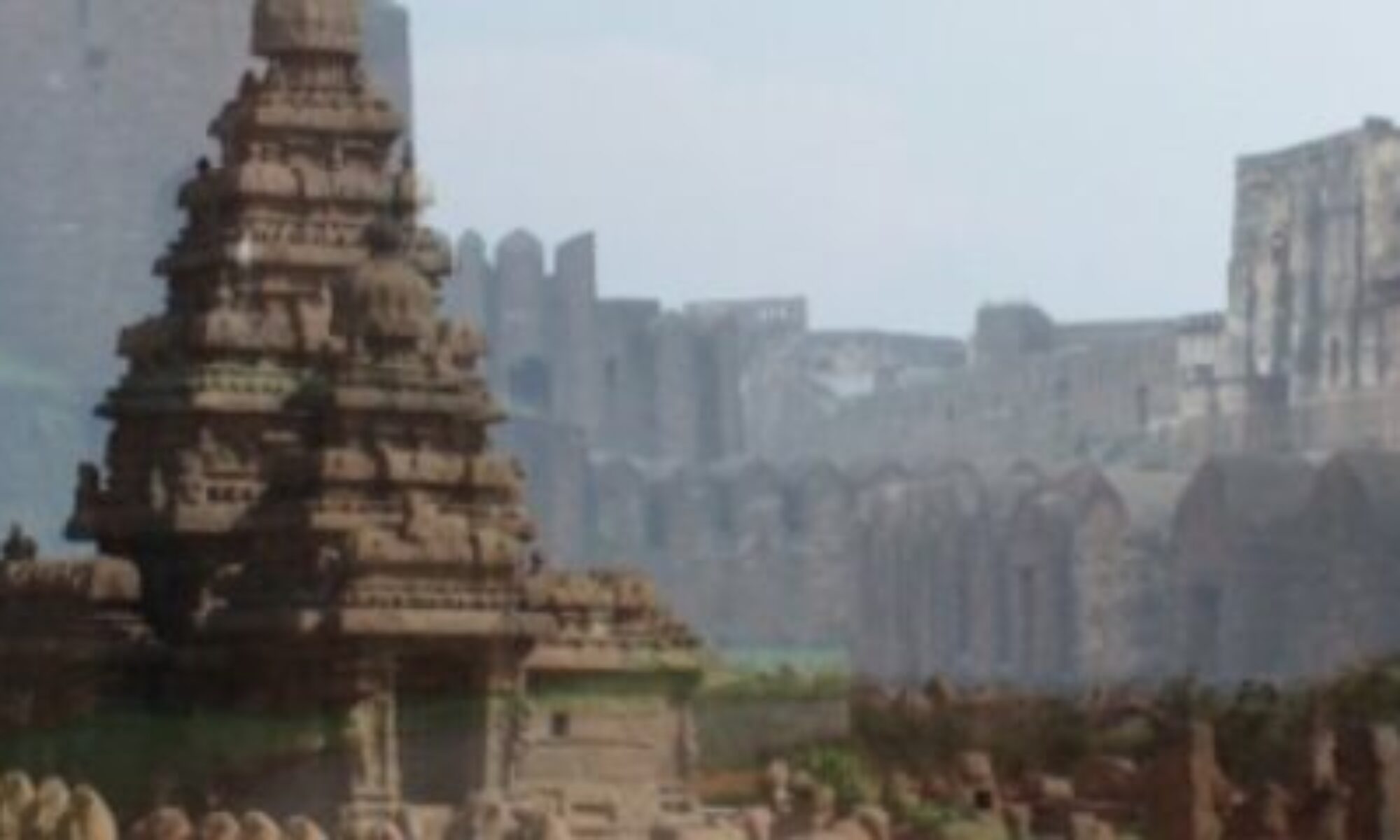This vihara is a novel conception. It seems to rest on the shoulders of a row of elephants. It was once adorned with a magnificent sculpted façade which, except for the traces of sculptures and chaitya 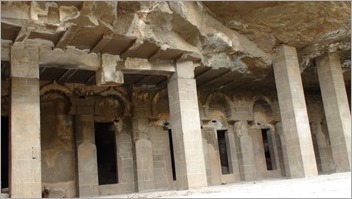 ornamentation at its top is now damaged owing to the breaking off of huge blocks of rock at vulnerable points in this rather poor quality of trap full of seams and fissures. Of the remnants of the façade a row of six chaitya-windows with the interior decorated with a recessed window pattern and animal figures between the semi-circular vedika pattern is seen.
ornamentation at its top is now damaged owing to the breaking off of huge blocks of rock at vulnerable points in this rather poor quality of trap full of seams and fissures. Of the remnants of the façade a row of six chaitya-windows with the interior decorated with a recessed window pattern and animal figures between the semi-circular vedika pattern is seen.
The cave consists of a series of seven cells in the back with a verandah in the front, most of the pillars of which have been recently reconstructed. It appears that there were two more rows of pillars, supporting the roof of the vihara, but they have now perished leaving square incisions on the floor to indicate their positions. The collapse of the façade has marred the view of what at one time been a magnificent entrance, and consequent accumulation of debris in the forecourt misled people to think that the steps in front belonged to an underground passage leading to the stream. The clearance of the debris has bought to light a high plinth with a splendid series of elephants carved on its edg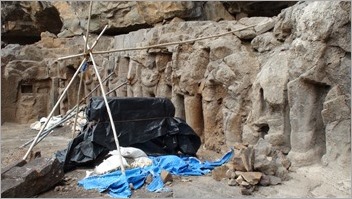 e and a very ornate entrance on the extreme left, flanked by dwarapalas holding javelins and shields in hand. The sculptures of elephants, half projecting forward with the sculpted mahouts standing in front, and other sculptures recovered from the debris constitute a priceless treasure of early art.
e and a very ornate entrance on the extreme left, flanked by dwarapalas holding javelins and shields in hand. The sculptures of elephants, half projecting forward with the sculpted mahouts standing in front, and other sculptures recovered from the debris constitute a priceless treasure of early art.
The elephants, with their massive and rather stiff forelegs, are shown as stepping forward out of a shelf cut below the floor of the cave and appear to bear the weight of the cave. Pearl ornaments and pendants hang down from the upper ear-lobes and at the lower ends are suspended bells resting on the trappings. In place of tusks, there are holes probably to receive detachable decorated ivory or wooden tusks, though in some cases the tusks are carved in stone itself and have floral wreaths attached.
A feature which needs special mention is the very ingenious arrangement of diverting water that found its way into the cave through cracks; long tunnel like openings were bored into the ceiling and the water was allowed to flow f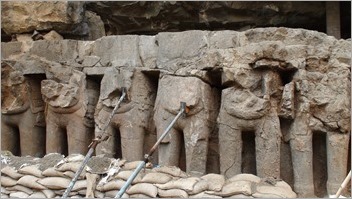 ully into the cave, in the floor of which a channel was cut to lead the water outside near the entrance. There are two such openings in the ceiling of the cave, one of the right side of the back cell and the other in right side cell.
ully into the cave, in the floor of which a channel was cut to lead the water outside near the entrance. There are two such openings in the ceiling of the cave, one of the right side of the back cell and the other in right side cell.
The entrance doorway, has its jambs ornamented with beautiful designs of half-lotuses and the tri-ratna. Just behind the jambs are circular sockets for fixing wooden door-leaves. On each side in front stands a very dignified dwarapala, clad in a dhoti and a close fitting tunic and holding a javelin in one and and a shield in the other. The shields are oblong in shape and their ends are decorated with tassels and small bells.
The right dwarapala has a short dagger in a broad scabbard attached to his belt which is just seen behind the shield. Both the sculptures are remarkable for their very realistic modeling, the depiction of garments and a smiling expression, which nevertheless bespeaks strength and vigor. Their faces show bulging and fleshy cheeks, thick lips and wide open eyes. Their headdress formed by the knot of the turban decorated with pearl-stringed malas, remind the ones at Amaravati.
Over the head of each dwarapala is an elephant in profile, the trunk missing. Over the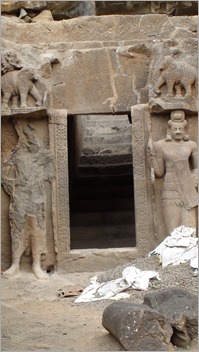 left elephant is a damaged sculpture if a kinnara (celestial lady). Set within these two elephants and above the doorway was an oblong panel of Gaja-Lakshmi, now fallen from its original place.
left elephant is a damaged sculpture if a kinnara (celestial lady). Set within these two elephants and above the doorway was an oblong panel of Gaja-Lakshmi, now fallen from its original place.
The cave is also important account of its inscriptions. The ones previously known are engraved on the opening of each cell. The donors are in all cases members of the family of the royal physician. A distinct depiction of one inscription discovered on a horse consists of two lines, of which the upper one is badly damaged. It reads as follows.
Line 1 [Dhe]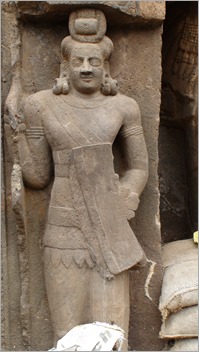 nuk [aka] tasa Samasa-putena Ka-
nuk [aka] tasa Samasa-putena Ka-
Line 2 nhena kata
“Done by Kanha (Krishna), the son of Samasa, of Dhenukataka”
Dhenukataka or Dhanyakataka as it was originally pronounced, was the capital city of the Satavahana empire which spanned Andhra Pradesh and Maharashtra. Dhanyakataka is also mentioned in the inscriptions at Karla, Kanheri and Shelarwadi. On paleographical grounds, the inscription can be ascribed to the second century B.C.
The next inscription carved on a pilaster in the left wall reads…. ya bhichhuniya dana[m] tha[bho], means the pillar (is) the gift of the nun…. This inscription may be ascribed to the second century B.C
The third inscription is on the left wall in line with the modern pillars, however it is too fragmentary and the few discernable Bramhi letters do not convey any meaning.
